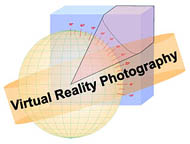 |
Case Study: Review of VR Pan Heads
|
 |
Case Study: Review of VR Pan Heads
|
![]()
Review by Scott Highton for Virtual Reality Photography (www.vrphotography.com)
December, 2006
The extensive review of these three leading VR pan heads was originally done in 2003, and updated at the end of 2004. All three manufacturers have since made major updates and improvements to their products, and the original review is no longer applicable to any of them. In fairness to all these manufacturers, we have removed most of the now-dated review from the VR Photography web site, and hope that you will consider their latest product offerings based on the latest model information from the manufacturers.
Below, you can still find selections from the review which are still applicable, as well as descriptions of some of the criteria we used to test the pan heads and links to other relevant information.
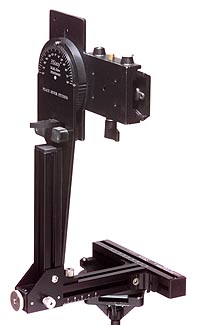 |
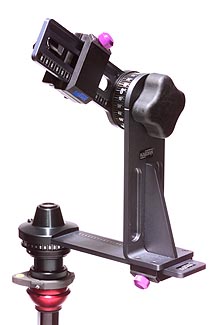 |
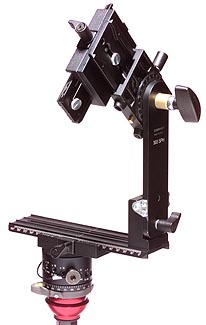 |
|
Peace River Studios 3Sixty
|
Kaidan QuickPan III Spherical
|
Manfrotto 303 SPH (Spherical)
|
We evaluated the heads based upon priorities common to many working photographers:
There were a number of elements that we attempted to quantify in the above areas. We considered other factors as well, many of which were prompted by our experiences during actual VR shoots.
![]()
Size and Weight
These are important considerations for photographers having to carry their equipment in the field. For the average photographer, a 20 pound shoulder bag is about as much as can be carried comfortably for an extended period, such as on a photojournalism assignment. Twenty pounds of camera equipment is also a significant addition to the load a backpacker would normally carry (a 35-40 lb. backpack is pushing the limit of extended comfort on the trail.) The amount of space a VR head takes in your camera bag, combined with how much it adds to the weight you must carry, can often make the difference between whether your VR gear gets included or not.
While these new heads are significantly improved over previous models, weight is still a bit of a problem. They all weigh about 4 pounds, which winds up being about 20 percent of the comfortable camera bag load. Add to that the weight of a tripod and a leveling device, along with camera and lens, and there’s not much allowance left for other gear.
![]()
Storage Space
All three manufacturers have included the ability to collapse or fold their VR heads for packing and transport. Earlier models had large metal pieces fixed at right angles to one another, which made packing the heads into a camera bag difficult at best. For this review, we measured the minimum space that the heads could be packed into when collapsed. Since most VR photographers use a single camera and lens combination for the majority of their panoramic work, we also looked at whether a preset entrance pupil alignment could be maintained when the heads were folded. One of the long time aggravations of VR shooting is having to realign your lens' entrance pupil every time you set the head up. This slows down your shooting process and introduces one more possibility for error (forgetting to realign) that may not be discovered until after the fact. It’s better to be able to set and lock your entrance pupil alignment in a more controlled and low pressure environment than during an actual shoot, and then to know that the head is already pre-aligned when you set it up again. (For more on entrance pupil alignment, click here.)
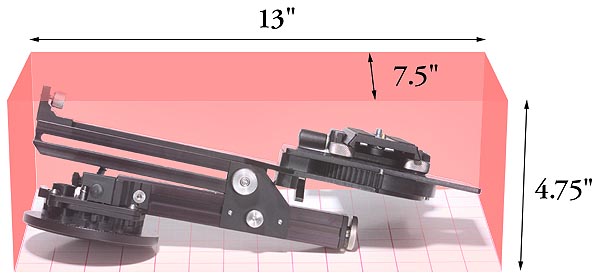 |
|
Peace River Studios' 3Sixty head folded for storage
|
![]()
Operation Space
The space required to use the heads when assembled is another important consideration for some photographers, particularly those shooting in confined spaces such as aircraft cockpits or automobile interiors. We therefore measured the movement of the assembled head throughout its pan and tilt ranges. Additional clearance space is also needed to allow for a camera support (such as a tripod), head leveling mechanism and of course photographer access.
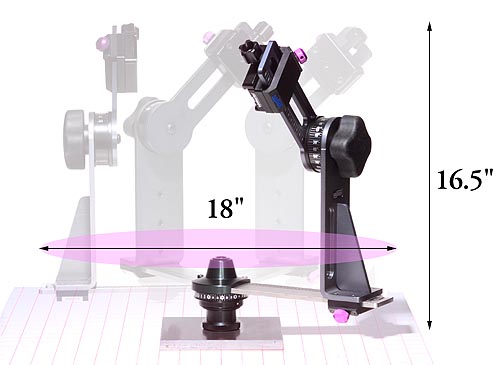 |
|
Kaidan QuickPan III minimum space for multi-row shooting
|
Surprisingly, we found all three heads required similar working spaces. The Kaidan QPIII required a clearance of 18” wide x 18” deep x 16-1/2” high. The Manfrotto 303SPH required 18”w x 18”d x 15-1/2h”, which was the shortest headroom requirement. The Peace River 3Sixty had the smallest operating radius of 16”w x 16”d x 18”h.
Both the Peace River and Manfrotto heads can be configured for even smaller spaces, if your camera alignment allows it. Peace River is willing to cut custom rail sections (the stock 3Sixty is designed with three matching 6-5/8" long extruded aluminum arms) for an additional price. However, the Manfrotto 303SPH comes standard with two interchangeable sets of plates (5-1/2" and 8-1/4" long). Choose the shorter ones to save on size and weight, as long as they provide the alignment space your camera needs. Otherwise, use the longer plates or a combination of both.
![]()
Design and Function
Satisfaction with design and function of VR equipment is often subjective at best. Photographers will frequently choose hardware based on its general “feel” and whether it performs its needed functions effectively and simply. Confusing mechanisms that require modification or extra effort in the field merely increase the workload for the photographer, and they present further potential for failure in what may already be high pressure shooting situations.
![]()
Deflection (Sag) Under Load
The first criteria we looked at was the strength of the heads. To quanitfy this, we measured how far out of “square” each head deviated when burdened with the weight of a camera and lens combination.
This is a typical shooting problem, because image sequences shot with the camera as little as half a degree (0.5°) off of vertical alignment can cause noticeable stitching errors at higher resolution assemblies. Even though the tripod head may be perfectly level, the camera itself may not be vertical if there is too much flex in the brackets holding the camera. If the camera is rotated off axis, the horizon lines between shots will not properly match up and the stitched panorama will wind up with a “stair stepped” assembly.
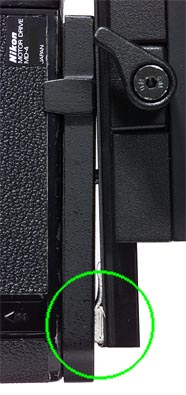 |
|
|
Manfrotto 303SPH head being measured for "sag" under weight
of Nikon F3 camera and 15mm nikkor lens (approx. 5 lbs.) Manfrotto has since added an adjustment set screw to compensate for vertical sag. |
A folded piece of tape can be used between camera base and plate to correct for "sag"
|
![]()
For this test we attached a Nikon F3 with MD-4 motor drive and 15mm Nikkor lens (total weight: about 5 lbs.) to each head and measured the deflection between the vertical film plane of the camera and the leveled base. Many photographers also rest their hand on the camera while shooting, inadvertently adding weight and tilting the camera even more. (This is another reason to use a remote or cable release so you avoid touching the camera during each exposure.) Thus, relative strength and stiffness of the VR head is fairly crucial.
It is possible to correct for these deviations, assuming you know about them, by simply adding one or more pieces of tape (or some other shim) under one end of the camera base when mounting it to the attachment plate. However, we’d prefer to see heads that hold their shape better under professional camera loads. Unfortunately, this seems to require designs made from thicker/heavier materials. A one degree alignment error is difficult to detect through a viewfinder under normal shooting conditions, yet it can be problematic for many stitching applications. In our opinion, photographers shouldn’t be expected to cobble together pieces of tape on state-of-the-art hardware to properly align everything.
![]()
Operation Complexity & General Construction
Next, we looked at the complexity of operation. In practical use, the size/number of knobs and their relation to the adjustments available correspond directly to the ease of use of the head. It is generally preferable to loosen or tighten the least number of knobs for each adjustment, and to have those knobs sized adequately to allow their use by a photographer wearing gloves during cold weather shooting.
The Kaidan QuickPan III head is probably the simplest in this regard. Its use requires five knobs or screws to adjust six major functions and movements. Each of these knobs is large enough to be loosened and tightened easily with heavy gloves on. We particularly liked the size of the tilt arm control knob.
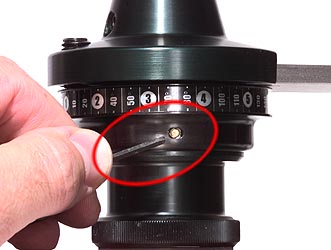 |
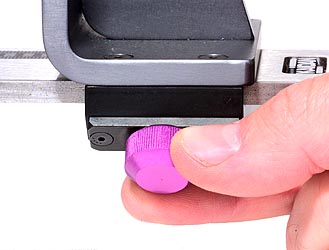 |
|
Changing QuickPan III detent rings
requires a small tool |
QuickPan III adjustment knobs are well sized
|
![]()
For those who need to change detent sets regularly but don't want to have to change rings, we’d recommend keeping a 24-detent ring installed on the QuickPan III (or using a 24-increment setting on other pan heads), and then skipping clicks as you pan to get your needed combinations. For a chart of pan increments and fields of view for 35mm cameras & lenses, see the accompanying Pan Increment & Fields of View Technical Note.
With 24 detents, each click represents 15° of pan (24 shots per 360° panorama). To shoot in 30° increments (12 shots), skip every other click. For 45° increments (8 shots), shoot from every third detent. For 60° increments (6 shots), move four clicks between shots, etc.
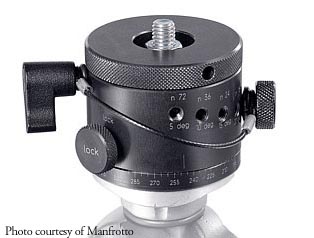 |
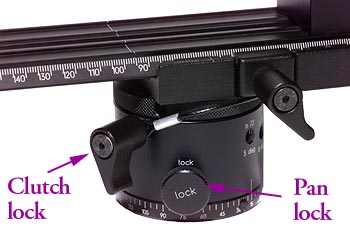 |
|
Manfrotto 300N Pan Rotation Unit
|
Manfrotto 303SPH (includes 300N)
|
Being able to select 5° or 10° increments between detents, combined with a standard camera plate connection on top of the rotator, means that you can also use the Manfrotto head as a turntable for shooting object VR movies. Simply attach a small plywood round (available from most hardware stores) centered on the top of the head, and you have an effective tripod–mounted turntable, suitable for shooting small and medium sized objects. I have also found that a laser level can be attached to this Pan Rotation Unit and used in the field to help align 5° or 10° camera positions for shooting object movie sequences around very large objects.
We encourage using a 3/8” mount for all three heads, particularly if you are mounting a heavier camera or using the head in non-vertical positions, such as on a boom arm through a window or sunroof for a car interior, or perhaps hanging it over the edge of a cliff, on the the side of a building, or even inverted from an overhead support. I believe the Manfrotto head is probably the best choice for such non-traditional positioning, because of both its robust design and its pan rotation lock.![]()
Captive Parts
Another reliability feature we looked for is whether critical parts of the heads were held captive while being adjusted. For example, if the screw that attaches a camera to the head needs to be completely removed, it can accidentally be dropped or lost, rendering the head somewhat useless. A good head design allows such parts to be loosened, but keeps them attached to the mechanism so they won’t be lost accidentally.
Both the Kaidan and Peace River heads are well designed in this regard. Critical parts are either held captive or do not require full removal when adjustments are made. The Manfrotto head also maintains this for most of its functions.
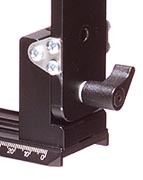 |
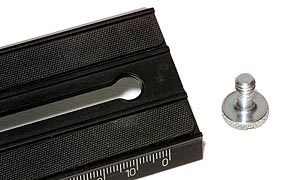 |
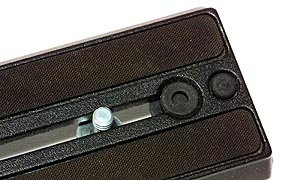 |
|
Vertical arm lock knob
|
Non-captive screw can be dropped or lost
|
Captive screw remains in place
|
![]()
Leveling Devices
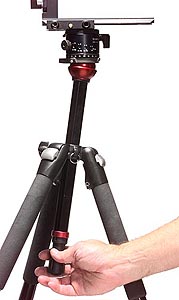 |
|
Manfrotto MDeVe Leveling Center Post
|
Many panoramic photographers use either a geared head or a standard ball head for an economical approach to this. Unfortunately, doing so adds bulk and weight to the equipment you have to carry. On the positive side, a ball head can also be used for most traditional tripod photography, so you may be carrying it already.
Even so, our favorite solution is a relatively new support column from Manfrotto that incorporates a ball & socket design similar to high end cinema tripods in a very small and elegant package. A grip at the bottom of the column loosens and tightens the leveling mechanism. This column replaces the existing center post on most Manfrotto tripods. Since it contains its own leveling device, it gives you many of the benefits of a ball head without extra bulk or weight (its adjustment range is considerably less than a traditional ball head, however). Several models are available to fit most Manfrotto tripods (Models 554, 555 and 556, along with Manfrotto’s MDeVe video tripod line).
![]()
Both Manfrotto and Kaidan offer alternate leveling bases that employ three threaded horizontal wheels. Their range of adjustment is quite limited, but they do offer fairly precise leveling control. Manfrotto’s 338 Leveling Base weighs about 1 lb. 5 oz. while Kaidan’s version – the QuickTilt Leveler, weighs almost 30 percent less (about 15 oz.).
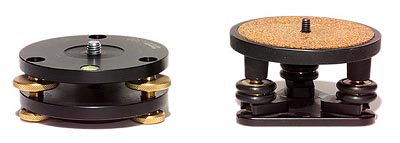 |
|
Manfrotto 338 Leveling Base (left) and Kaidan QuickTilt leveler
|
![]()
Other Pan Heads
While we have focused this review on the high end models from the three manufacturers, there are additional configurations from each that we should touch upon for reference.
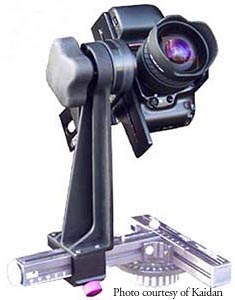 |
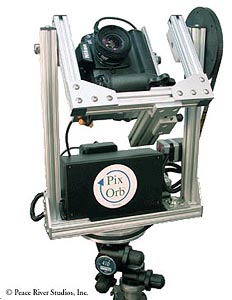 |
|
Kaidan Spherical arm for Peace River 3Sixty
|
Peace River Studios' automated PixOrb™ |
Peace River Studios offers its 3Sixty without the Multi-row Attachment. This model is acceptable if you only plan to shoot single row or cylindrical panoramas. However, if you want multi-row capability (for cubic or spherical panoramas), you will need to purchase Peace River’s Multi-row Attachment. An alternative is available from Kaidan however, which offers the Kaidan Spherical Arm attachment for the Peace River 3Sixty for about a 35 percent savings over the Peace River attachment. If you already own a Peace River 3Sixty and want to add multi-row shooting capability, you might want to consider this option. Note that Peace River Studios has not tested and does not provide technical support for the Kaidan Spherical Arm, however.
Peace River also offers an automated pan head called the PixOrb, which offers motorized remote operation of both camera triggering and multi-row pan sequencing. The unit is significantly more expensive than the manually operated 3Sixty, but can be operated independently in the field or via custom Peace River software running on a Macintosh computer.
![]()
Final Thoughts
Design of a VR pan head seems simple on the surface – simply attach an L-bracket (to orient the camera vertically) on top of a panning rotator unit. However, the reality of a good design is far more complex when one has to include the ability to align all the necessary camera movements (front/back, left/right, tilt up/down, panning and leveling) with the variable nodal point positions of an almost infinite variety of camera and lens combinations.
Many photographers have designed and built their own custom heads. Some of these are quite elegant and offer an ideal combination of function, small size, low weight and low cost. This is possible because they are designed for a specific camera and lens. Designing similar hardware as a commercial product demands accommodation of multiple camera/lens combinations, manufacturing efficiency and a number of tradeoffs between size, weight, functionality and price.
The VR community is indeed fortunate to have these three leading companies, along with a small handful of others, producing commercial VR hardware and continually improving their products. They’ve helped photographers come a long way from the early days of VR, when most of us had to build our equipment from scratch or to assemble it from a variety of expensive and often hard to find products designed for other uses. The results were generally cumbersome and user “unfriendly”.
While we may still discover occasional flaws in these top commercial VR heads, they do represent the best of what’s available today. They are the result of many thousands of hours of design, manufacturing, testing and improvement that none of us could have accomplished on our own.
We at Virtual Reality Photography hope you will consider these manufacturers’ products favorably when making your own equipment choices.
![]()
Contact info:
|
|
Kaidan: www.kaidan.com Manfrotto: www.manfrotto.com Peace River Studios: www.peaceriverstudios.com |
![]()